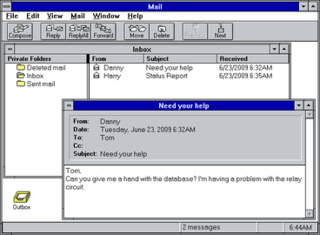Related Research Articles
Microsoft Windows was announced by Bill Gates on November 10, 1983. Microsoft introduced Windows as a graphical user interface for MS-DOS, which had been introduced two years earlier. The product line evolved in the 1990s from an operating environment into a fully complete, modern operating system over two lines of development, each with their own separate codebase.

Windows 95 is a consumer-oriented operating system developed by Microsoft as part of its Windows 9x family of operating systems. The first operating system in the 9x family, it is the successor to Windows 3.1x, and was released to manufacturing on July 14, 1995, and generally to retail on August 24, 1995, almost three months after the release of Windows NT 3.51. Windows 95 is the first version of Microsoft Windows to include the start button. Windows 95 merged Microsoft's formerly separate MS-DOS and Microsoft Windows products, and featured significant improvements over its predecessor, most notably in the graphical user interface (GUI) and in its simplified "plug-and-play" features. There were also major changes made to the core components of the operating system, such as moving from a mainly cooperatively multitasked 16-bit architecture to a 32-bit preemptive multitasking architecture, at least when running only 32-bit protected mode applications.

Windows 9x is a generic term referring to a series of Microsoft Windows computer operating systems produced from 1995 to 2000, which were based on the Windows 95 kernel and its underlying foundation of MS-DOS, both of which were updated in subsequent versions. The first version in the 9x series was Windows 95, which was succeeded by Windows 98 and then Windows Me, which was the third and last version of Windows on the 9x line, until the series was superseded by Windows XP.
Windows Chat is a simple LAN-based text chatting program included in Windows for Workgroups and, later, the Windows NT-line of operating systems, including Windows NT 3.x, NT 4.0, Windows 2000, Windows XP and Windows Server 2003. In later Windows versions, the Network DDE service may need to be enabled to receive calls. It utilizes the NetBIOS session service and NetDDE. Users can chat with each other over an IPX LAN. The shortcut to the executable is not present in the Start Menu in newer versions of Windows; it must instead be run by using Start > Run... > WinChat.exe.

Windows NT 4.0 is a major release of the Windows NT operating system developed by Microsoft and oriented towards businesses. It is the direct successor to Windows NT 3.51, and was released to manufacturing on July 31, 1996, and then to retail in August 24, 1996, with the Server versions released to retail in September 1996.
Win4Lin is a discontinued proprietary software application for Linux which allowed users to run a copy of Windows 9x, Windows 2000 or Windows XP applications on their Linux desktop. Win4Lin was based on Merge software, a product which changed owners several times until it was bought by Win4Lin Inc. Citing changes in the desktop virtualization industry, the software's publisher, Virtual Bridges, has discontinued Win4Lin Pro.

Microsoft Project is a project management software product, developed and sold by Microsoft. It is designed to assist a project manager in developing a schedule, assigning resources to tasks, tracking progress, managing the budget, and analyzing workloads.

Norton Utilities is a utility software suite designed to help analyze, configure, optimize and maintain a computer. The latest version of the original series of Norton Utilities is Norton Utilities 16 for Windows XP/Vista/7/8 was released 26 October 2012.

Microsoft Mail was the name given to several early Microsoft e-mail products for local area networks, primarily two architectures: one for Macintosh networks, and one for PC architecture-based LANs. All were eventually replaced by the Exchange and Outlook product lines.

Imaging for Windows from Global 360 is document imaging software. Earlier versions of Imaging for Windows were available for Windows 95-98/Me/NT/2000. Global360 Imaging for Windows is the upgrade to this Imaging software, which was discontinued as of Windows XP. Its image viewing, editing and scanning functions are superseded by Windows Picture and Fax Viewer and Microsoft Paint, both of which are based on GDI+ in Windows XP. However, the multi-page picture editing functions are gone with the Imaging software.

Delrina Corporation was a Canadian software company active from 1988 to 1995. The company was best known for WinFax, a software package which enabled computers equipped with fax modems to transmit copies of documents to standalone fax machines or other similarly equipped computers. It also sold PerForm and FormFlow, electronic form software. Delrina was acquired by the American software firm Symantec in 1995.

Microsoft Internet Explorer 4 (IE4) is the fourth, and by now, discontinued, version of the Internet Explorer graphical web browser that Microsoft unveiled in Spring of 1997, and released on September 22, 1997, primarily for Microsoft Windows, but also with versions available for the classic Mac OS, Solaris, and HP-UX and marketed as "The Web the Way You Want It".

File Manager is a file manager program bundled with releases of OS/2 and Microsoft Windows between 1988 and 1999 and available from 6 April 2018 as an optional download for all modern releases of Windows, including Windows 10.
WinComm was a terminal emulator program for Windows that was offered by Delrina in the mid-1990s.
AudioFile was a software company that was founded in Massachusetts in 1990. It was founded under Venture Capital Investment by the Massachusetts Technology Development Corporation.
CommSuite 95 is a communications software suite launched in 1995 by Canadian software company Delrina.
Hilgraeve is a software firm based in Monroe, Michigan, and is best known for its HyperTerminal Private Edition and HyperACCESS programs. In earlier years, HyperTerminal had been licensed for use by Microsoft in versions of Windows ranging from Windows 95 to Windows XP.

Norton SystemWorks is a discontinued utility software suite by Symantec Corp. It integrates three of Symantec's most popular products – Norton Utilities, Norton CrashGuard and Norton AntiVirus – into one program designed to simplify solving common PC issues. Backup software was added later to high-end editions. SystemWorks was innovative in that it combined several applications into an all-in-one software for managing computer health, thus saving significant costs and time often spent on using different unrelated programs. SystemWorks, which was introduced in 1998 has since inspired a host of competitors such as iolo System Mechanic, McAfee Nuts And Bolts, Badosoft First Aid and many others.
SYSTEM.INI is an initialization used in early versions of Microsoft Windows to load device drivers and the default Windows shell, among other system settings. Many of these settings were honored in Windows 9x, although the INI files had begun to be phased out in favor of the Windows Registry. Windows NT 4.0, 2000, XP and Server 2003 still acknowledge some SYSTEM.INI entries in order to provide backwards compatibility with older 16-bit applications. Windows Vista and beyond also have SYSTEM.INI as well. However, when a fresh install of XP/Server 2003 is performed, the SYSTEM.INI file created contains by default only these lines:
Windows NT is a proprietary graphical operating system produced by Microsoft, the first version of which was released on July 27, 1993. It is a processor-independent, multiprocessing and multi-user operating system.
References
- 1 2 Lawrence M. Fisher (July 7, 1995). "Symantec Offers To Buy Delrina As Windows 95 Release Nears". The New York Times .
- ↑ "Delrina: Network version of WinFax Pro". Computerworld . June 7, 1993. p. 55.
- ↑ Nina Munk (April 24, 1995). "Fax Killer". Forbes . p. 74.
- ↑ "WinFax Pro 10.0". WinWorld .
- ↑ "WinFax Pro". Computerworld . August 17, 1992. p. 75.
- ↑ "NetTalk newsletter" (PDF). 1 August 1997.
WinFax Pro .. makes the fax line look just like another printer.
- ↑ Laurie Flynn (January 15, 1995). "New Software Promises to Make the PC a Viable Fax Option". The New York Times .
- ↑ "Symantec bid for Delrina highlights plans for Windows 95 mobile users". Computerworld . July 10, 1995.
- ↑ "The Best CEO in Silicon Valley". Black Enterprise . September 2004.
- ↑ "Electronic Medical". Praxis EMR Newsletter. Winter 2011.
WinFax is no longer supported by Symantec
- ↑ Mitchell Martin (November 22, 1993). "French Entrepreneurs Cash In on Fax Modems". The New York Times .